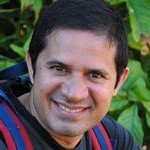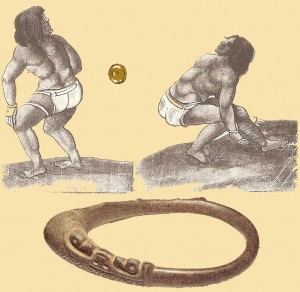National Geographic Society honored Cuban scientist Daniel Torres Etayo with its Emerging Explorer award.
Daniel Torres Etayo’s fieldwork spans thick jungles, hidden caves, dune-swept beaches, and ocean depths—all within the archaeologically rich, yet largely unexplored, borders of Cuba. The societies he investigates are as diverse as his sites, ranging from 13th-century aboriginal Tainos to 19th-century New Yorkers. His personal passion and perseverance in exploring, communicating discoveries, and training new talent have been responsible for putting Cuban archaeology on the map.
Today he hopes his own discoveries will inspire a new generation of young Cubans to explore and protect their heritage. “I know Cuba still has a wealth of unexplored archaeological sites. When I began researching the eastern region of the island, there were about 15 known sites. Today my own inventory includes more than a hundred, and this is just the tip of the island.”
New finds won’t be limited to land. Torres Etayo says almost 3,000 shipwrecks off Cuba’s coast are noted in archives, only about a hundred of which have been located, and only 12 excavated.
One key project transports Torres Etayo to the tribal life of 13th-century Cuba. He explores massive ceremonial centers to gain new understanding of local history, customs, and world views, and to learn how native Taino societies were changed by European contact. At one site, he studies a huge 820-foot-by-440-foot space enclosed by almost 10-foot-high walls where tribal communities may have joined in Areito, a ceremonial music often accompanied by song and dance, as well as batey, a traditional ball game.
Torres Etayo not only explores and documents the find, but also is working to have it preserved as a local monument and sustainable biocultural reserve. Non-divers will be able to take a 360-degree virtual tour of the wreck, created with detailed photographs, historical archives, and information about local marine fauna.
Many of his innovative underwater search techniques are a first for Cuba. “We are making a mega-photomosaic of the entire site,” he explains. “A diver navigates an underwater grid and shoots one photo every two seconds at fixed depth. The results produce an enormous scaled and geo-referenced photomosaic of the site. I hope that when people visualize this marvelous underwater world, they will be encouraged to be active in the protection and preservation of our submerged archeological heritage.”
TAINO VOLLEYBALL
Another research that tipped the scales in favor of Daniel to the jury of the National Geographic was a project developed since 2005 in the municipality of Maisi, Guantanamo province, on Aboriginal ceremonial plazas, best known at the time of the discovery of America as “bateyes.”
The batey is characteristic of the Taino culture, and it was the same as the so-called colonial mills of. According to Father de las Casas, that word meant three things at once: the game, the ball was played and the square where it was.
“It was actually rather like a game of volleyball, where the natives gave the ball to all parts of the body: hips, feet, head … except with his hands. The ball was very hard, made of resin, and bounced a lot. The chroniclers of the time said it was better than those used in Europe, made from animal bladders.
“The players were placed in a square, like a current playground, and distributed into two camps. Sometimes they played men against women, village against village, two groups within these …
“The most important thing is that in addition to playfulness, that had a symbolic meaning and probably at the level of religious beliefs. It was like a festival involving the whole community.
“Even made bets. For villages against villages, and meals were played were great celebrations. Through archaeological studies I could find in some bateyes the remains of those potential celebrations with food. They are found along one of the walls, as if there had put a “Swedish table”, if we use a modern image, “said the specialist.
In the case of Cuba, said it may be retained only four bateyes, all Maisí exclusive. Etayo Torres’s work is thoroughly documenting through advanced means.
“The bateyes are a fundamental phenomenon of the Greater Antilles, but Cubans have special features as archaeological and historical documentation,” said the researcher.
“In Puerto Rico, for example, places are bounded by stone slabs placed vertically. In Spanish, we found stone and rammed earth walls (ridges). In Cuba are only ridges.
“But what most distinguishes the Cuban places is that its dimensions are totally disproportionate in size. Compared with other Dominican Republic, Puerto Rico and Haiti, ours are huge.
“The largest is in a place called Pueblo Viejo. It measures 250 meters long by 135 wide and was discovered in 1843. The other three found them an American archaeologist, Mark Raymond Harrington, who was in our archipelago in 1915 and in 1919.
“What I find amazing is that this has escaped them archaeologists. Because how can you be so large? Imagine a wall that is 15 feet at its base, three meters high and measuring a total of two and a half blocks long, “he explained.
The Pueblo Viejo-batey-pointed is the largest, but unfortunately it is the most destroyed. “On it stands a village with schools, churches, warehouses … To us find it very difficult to see and study the structure, but we can still see the walls. ”
“The best preserved of Cuba and the Antilles, is the Laguna de Lemons. While not as big as the Old Town, it is much higher than those documented in neighboring countries. It is an archaeological gem we have in our country and unfortunately the people know.
“The other two would be the San Lucas, which is just a single wall, and Montecristo. The latter has not been seen again after the American archaeologist discovered it. So one of the objectives of the project is relocalizarlo, if it exists and has not destroyed agriculture. ”
Sources: NationalGeographicSociety/InternetPhotos/TheCubanHistory.com
National Geographic honor Cuba Scientist/ The Cuban history/ Arnoldo Varona, Editor
SOCIEDAD NATIONAL GEOGRAPHIC PREMIA ARQUEOLOGO CUBANO
El trabajo de Daniel Torres Etayo se extiende por espesas selvas, cuevas escondidas, playas de dunas barridas, y el océano profundo, todo dentro de los arqueológicamente rico, en gran parte inexplorada, las fronteras de Cuba. Las sociedades que investiga son tan diversos como sus sitios, que van desde el 13 del siglo aborígenes Tainos siglo 19 neoyorquinos. Su pasión personal y la perseverancia en la exploración, descubrimientos comunicación, formación y talento nuevo se han encargado de poner la arqueología cubana en el mapa.
Hoy se espera que sus propios descubrimientos inspire a una nueva generación de jóvenes cubanos para explorar y proteger su patrimonio. “Sé que Cuba todavía tiene una gran cantidad de sitios arqueológicos inexplorados. Cuando empecé a investigar la región oriental de la isla, había alrededor de 15 sitios conocidos. Hoy mi propio inventario incluye más de un centenar, y esto es sólo la punta de la isla . ”
Nuevos hallazgos no se limitará a la tierra. Torres Etayo dice casi 3.000 naufragios en la costa de Cuba se anotan en los archivos, sólo alrededor de un centenar de los cuales han sido localizados, y excavado sólo 12.
Uno de los proyectos clave de transporte Torres Etayo a la vida tribal, de 13 de siglo Cuba. Él explora enormes centros ceremoniales para obtener una nueva comprensión de la historia local, las costumbres y visiones del mundo, y para aprender cómo las sociedades indígenas taínos fueron cambiadas por el contacto europeo. En un sitio, estudia un enorme espacio de 820 pies por 440 pies encerrado por casi 10 metros de altura las paredes donde las comunidades tribales pueden haber unido en Areito, una música ceremonial a menudo acompañada por el canto y la danza, así como batey , un juego de pelota tradicional.
Torres Etayo no sólo explora y documenta el hallazgo, pero también está trabajando para que se conserva como un monumento local y reserva biocultural sostenible. Los no buceadores podrán hacer un recorrido virtual de 360 grados de los restos del naufragio, creado con fotografías detalladas, archivos históricos, así como información sobre la fauna marina local.
Muchos de sus innovadoras técnicas de búsqueda bajo el agua son una novedad para Cuba. “Estamos haciendo una mega-fotomosaico de todo el sitio”, explica. “Un buzo se desplaza una red bajo el agua y dispara una foto cada dos segundos a profundidad fija. Los resultados producen un fotomosaico enorme escala y georreferenciado del sitio. Espero que cuando la gente visualizar este maravilloso mundo submarino, se les anima a ser activa en la protección y conservación de nuestro patrimonio arqueológico sumergido “.
TAINO VOLEIBOL
Otra de las investigaciones del arqueólogo que llamó la atención del jurado de National Geographic fue uno en el municipio de Maisí, provincia de Guantánamo. En marcha desde 2005, Torres ha estado estudiando indígenas plazas ceremoniales, conocidos desde los primeros días de la colonización europea como “bateyes”.
Bateyes son característicos de la cultura taína, pero difieren de las encontradas en los asentamientos coloniales azucareros descritos por el término. Según el padre Las Casas, la palabra tiene tres significados relacionados: un juego, el balón en el juego y la plaza donde se jugó el partido.
En el caso de Cuba, dijo Torres, sólo cuatro bateyes se han conservado, todo en Maisí. Su trabajo consiste en documentar exhaustivamente sus características con las herramientas más avanzadas.
“Bateyes eran un fenómeno fundamental en las Antillas Mayores, pero los cubanos tenían características especiales de acuerdo a los registros arqueológicos e históricos”, explicó.
“Lo que distingue a las plazas de Cuba es que sus dimensiones son extraordinarias. Comparada con las de la República Dominicana, Puerto Rico y Haití, los nuestros son gigantescas.
“El más grande se encuentra en un lugar llamado Pueblo Viejo. Está a 250 metros de largo por 135 de ancho y fue descubierto en 1843. Las otras tres fueron encontrados por EE.UU. arqueólogo Mark Raymond Harrington, quien se encontraba en nuestro archipiélago en 1915 y 1919.
“El mejor conservado en Cuba, y en todas las Antillas Mayores, es el de Laguna de Limones. Se trata de una joya arqueológica que tenemos en nuestro país, desgraciadamente poco conocido por la gente. Los otros dos se encuentran en San Lucas, con apenas una pared restante, más uno en el Montecristo. Este último no ha sido estudiado desde los arqueólogos estadounidenses lo descubrió. Así, uno de los objetivos del proyecto es para reubicar, si es que todavía existe y no ha sido destruida por la agricultura “.
Sources: NationalGeographicSociety/InternetPhotos/TheCubanHistory.com
National Geographic honor Cuba Scientist/ The Cuban history/ Arnoldo Varona, Editor






